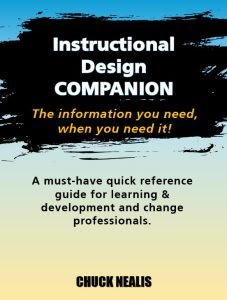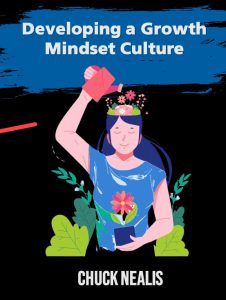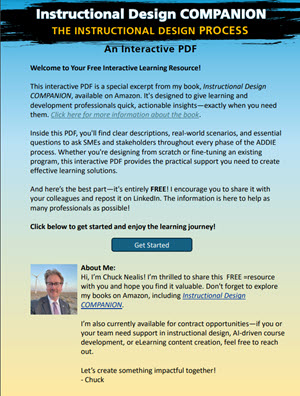
– MONTH OF OCTOBER SALE –
PAPERBACK BOOKSALE
“Developing a Growth Mindset Culture”
Regularly $19.99 NOW $9.99
Great Christmas Gift
HARDCOVER BOOKSALE
“Instructional Design COMPANION”
Regularly $39.99 NOW $24.99
Great Christmas Gift

Instructional Design COMPANION
Instructional Design Companion is your go-to guide for making the instructional design process more efficient and effective. Whether you’re navigating ADDIE, SAM, or developing curriculum, this book provides practical questions and tools that help you find solutions fast. Perfect for instructional designers and training professionals who need quick, actionable insights at every stage of their projects. This is a 350-page quick reference book which covers extremely important topics for learning professionals.

Developing a Growth Mindset Culture
Developing a Growth Mindset Culture is packed with practical strategies for fostering a culture of resilience, innovation, and continuous learning. Using humor, real-world examples, and actionable advice, this book helps leaders and teams break free from fixed mindsets, embrace challenges, and turn failures into steppingstones for success. A must-read for anyone looking to spark growth in their organization. The life lessons are practical for all ages. This is an easy 45-minute read.
Why Read This Book?
- Over 100 fun illustrations 🎨
- Easy and enjoyable read 😄
- Finish it in less than 45 minutes⏳
- Learn how to tackle business challenges with a smile 💪
- Perfect for business and personal growth 🚀

Streamline Your Instructional Design Process!
I’m excited to share a FREE, interactive PDF that breaks down the ADDIE process step-by-step. The most important feature? Key questions to ask SMEs and stakeholders at every phase! It’s a great resource to streamline instructional design for your team or colleagues.
Feel free to download the PDF and explore the content. Share it with your team, and let me know how it helps!
Best,
Chuck Nealis
NOTE: Download PDF file to properly play. Do not play in browser.

About the Author
Chuck Nealis is an accomplished Learning and Development professional with over 20 years of experience in instructional design, project management, and organizational change management. With a career that spans industries such as energy, cybersecurity, and corporate training, Chuck has honed his expertise in creating impactful training programs that drive both individual and organizational growth. His deep understanding of learning strategies and his ability to implement cutting-edge technologies have made him a trusted leader in the field.
Chuck is the author of two influential non-fiction books, Instructional Design COMPANION and Developing a Growth Mindset Culture. Both works reflect his commitment to enhancing workplace learning environments and fostering innovation through practical strategies. As a former Microsoft Partner for Dynamics CRM Training under the name Upward Momentum LLC, Chuck has also led large-scale training initiatives, consistently delivering measurable results.
In his spare time, Chuck is an avid cyclist. He also enjoys perfecting his writing craft.
3 Comments
Submit a Comment
@ 2024 Charles Nealis
We do not have any instructional designers on our team. If I pick up your book “Instructional Designn Companion,” will I be able to start developing courses?
Hi Sarah,
I am not going to minimize the importance of having a good instructional designer on your team. Having said that, as long as you have an authoring tool such as Articulate Rise, Storyline, Adobe Captivate, Lectora, or your choice of several others (and you know how to use them), Instructional Design COMPANION can be of great assistance. The section on ADDIE contains a mind map with the process steps you need to take en-route to course completion. In addition, each page has questions for you to ask subject matter experts (SMEs) and stakeholders during each step. You can join my network on LinkedIn (if we are not already connected), and we can discuss your situation further.
Thanks,
Chuck
As a follow-up, instructional designers have developed their craft over years. In addition, many are experts in video creation, scenario-building, gamification, creating assessments that work, and so much more. They have gone through the painstaking process of learning what works and what doesn’t work. There are sections in the book on pilot testing and overcoming objections which are good.